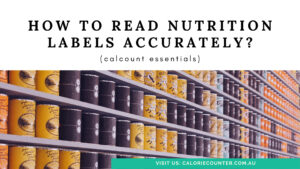Reading nutrition labels can be a little intimidating, but with a little bit of practice, it can be a valuable tool in helping you make healthier food choices. Nutrition labels provide important information about the content of the food you’re eating, including the number of calories, the amount of fat, protein, and carbohydrates, and the presence of essential vitamins and minerals. Here’s a step-by-step guide to help you read nutrition labels accurately.
Serving size
Start by looking at the serving size, which is listed at the top of the label. The rest of the information on the label is based on the serving size, so it’s important to pay attention to this number. If you eat more or less than the serving size, you’ll need to adjust the information accordingly.
Calories (and/or kJ)
The number of calories (or kilojoules) per serving is listed near the top of the label. This is an important number to pay attention to, especially if you’re trying to lose weight or maintain a healthy weight.
Macronutrients
The label will also show the amounts of fat, protein, and carbohydrates in each serving. These macronutrients are the building blocks of your diet, and it’s important to understand the balance of these nutrients in the food you’re eating.
Sodium
Sodium is an important nutrient to pay attention to, especially if you have high blood pressure or are trying to lower your salt intake. The amount of sodium in each serving is listed on the label.
Vitamins and minerals
The label will also show the amounts of important vitamins and minerals, such as vitamin A, vitamin C, iron, and calcium. These nutrients are essential for good health, and it’s important to pay attention to the amounts in the food you’re eating.
Ingredients list
Finally, take a look at the ingredients list. Ingredients are listed in order of quantity, so the first ingredient listed is the most abundant in the product. Keep an eye on which emulsifiers are included. This can be a useful tool in identifying added sugars or other ingredients you may want to avoid.
In conclusion, reading nutrition labels can be a valuable tool in helping you make healthier food choices. By understanding the information on the label, you can make informed decisions about the food you’re eating, and take control of your health and wellness. With a little bit of practice, you’ll soon be able to read nutrition labels with ease and confidence!









